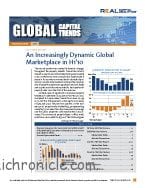 The second quarter of 2010 was marked by dynamic changes throughout the property markets, according the recently released RCA’s mid-year 2010 report on the state of the global commercial real estate developments.
The second quarter of 2010 was marked by dynamic changes throughout the property markets, according the recently released RCA’s mid-year 2010 report on the state of the global commercial real estate developments.
Transaction activity slowed in Asia Pac and not entirely due to governmental curbs instituted by China. Europe also experienced a pause in its recovery as worries about a double-dip recession scenario were renewed. However, the Americas which had yet to experience a significant rebound, finally saw a spike in activity and recorded its best quarter for property sales since the start of the recession.
Globally, sales of signifi cant commercial property totaled just under $100.0 b in Q2, down from $135.1 b in Q1. Compared to a year earlier, transactions were up 33% in Q2, but this still represents a slowing from increases of 138% and 91% in the prior two quarters. At the midyear point, property sales totaled $230.9 b representing a healthy 75% increase from the same period a year ago and the 5,600 properties sold represented a 28% increase. The commercial property types—offi ce, retail, industrial—accounted for $99.4 b of the total and grew at a slower rate than for hotel, apartments and land. EMEA had $62.6 b of transactions in H1’10, a 41% increase compared to H1’09. Commercial properties accounted for $47.1 b of the total including $21.0 b in Q2.
Despite the slowing of activity, yields on acquisitions fell by another 25 bps over the second quarter. Low yields in primary markets have prompted investors to look to secondary cities and emerging markets. Eastern Europe, particularly Poland, saw the greatest surge in transactions over the first half of the year. Western Europe was weighed down by declining transactions and rising cap rates in Spain and Italy. Asia Pac recorded $128.6 b of significant
transactions in the first half of the year, nearly double the volume from a year earlier.
However, transactions were greatly impacted by steps taken by China in early spring to reign in its property markets; property sales in China dropped to $26.1 b in Q2 from $63.4 b in Q1. Not all of the decline in property sales results from China, as it was also experienced in Japan and Australia. In addition, Hong Kong and Singapore which are more closely tied to China, continued to see robust property investment although the rate of growth slowed slightly. More importantly, yields on commercial property increased slightly even in Hong Kong, where cap rates were approaching peak levels.
The Americas recorded the greatest rise in transactions and decline in cap rates in the second quarter, a rebound 2-4 quarters behind the rest of the world. Office and hotel transactions in the US led the rebound but all other property types recorded gains as well and Canada and Brazil also performed well. Investment has been concentrated largely in major markets and core, low-risk properties resulting in record prices in a few situations, but relatively weak pricing for marginal assets in secondary markets.
While cross-border property acquisitions had declined dramatically since 2007 in all but the UK and US, the divergent trends that have emerged across global markets and even within regions, provide a great opportunity for international investors. Trends are improving in some areas, but starting to falter in others; transactions are up, but the market is far from efficient. Cross-border investment should increase in H2’10 as investors seek out opportunities and broaden their horizons.

































